Daniel W.W. Biostatistics: A Foundation for Analysis in the Health Sciences
Подождите немного. Документ загружается.

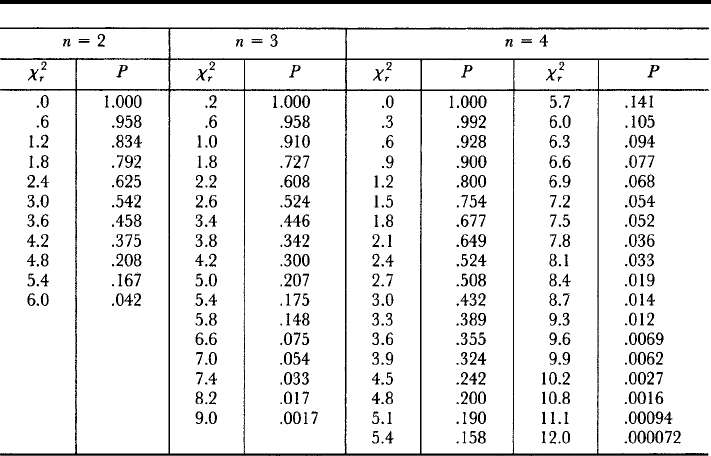
APPENDIX STATISTICAL TABLES A-103
TABLE Ob Exact Distribution of for Tables with from 2 to 9 Sets of Three
Ranks (
k
4;
n
2, 3, 4;
P
is the Probability of Obtaining a Value of as
Great as or Greater Than the Corresponding Value of )X
r
2
X
r
2
X
r
2
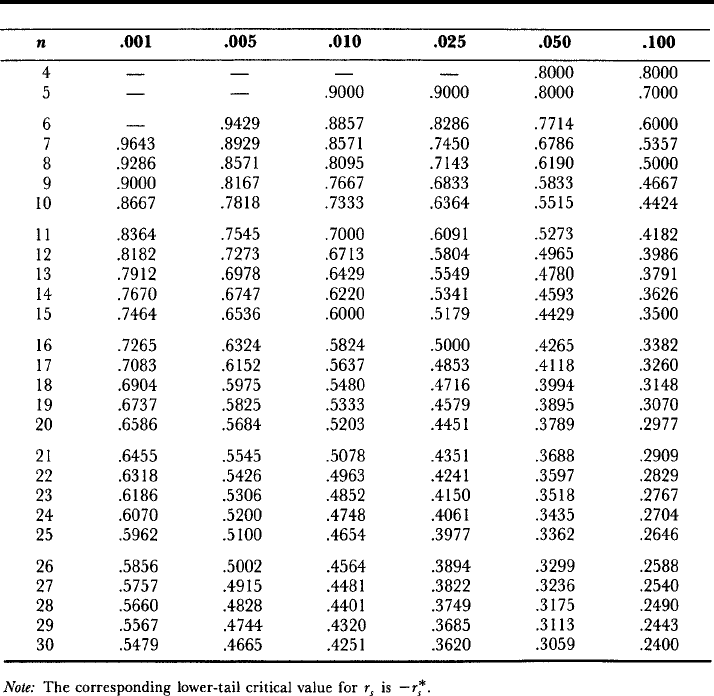
A-104 APPENDIX STATISTICAL TABLES
TABLE P Critical Values of the Spearman Test Statistic. Approximate Upper-Tail
Critical Values , Where Significance Level, AP (r>r
s
*
) ◊ A, n 4(1)30r
s
*

APPENDIX STATISTICAL TABLES A-105
ACKNOWLEDGMENTS FOR TABLES
A. From A Million Random Digits with 100,000 Normal Deviates by The Rand Corporation, the
Free Press, Glencoe, IL, 1955. Reprinted by permission.
E. Reproduced from Documenta Geigy, Scientific Tables, Seventh Edition, 1970, courtesy of CIBA-
Geigy Limited, Basel, Switzerland.
F. From A. Hald and S. A. Sinkbaek, “A Table of Percentage Points of the X
2
Distribution.” Skandi-
navisk Aktuarietidskrift, 33 (1950), 168–175. Used by permission.
G. From Biometrika Tables for Statisticians, Third Edition, Vol. I, Bentley House, London, 1970.
Reprinted by permission.
H. From Biometrika Tables for Statisticians, Third Edition, Vol. I, Bentley House, London, 1970. Used
by permission.
J. Entries for through from Table 38 of E. S. Pearson and H. O.
Hartley, Biometrika Tables for Statisticians, Volume 1, Third Edition, London: The Syndics of the
Cambridge University Press, 1966. Entries for through from
R. Latscha, “Tests of Significance in a Contingency Table: Extension of Finney’s Table,”
Biometrika, 40 (1953), 74–86; used by permission of the Biometrika Trustees.
K. From Frank Wilcoxon, S. K. Katti, and Roberta A. Wilcox, “Critical Values and Probability Lev-
els for the Wilcoxon Rank Sum Test and the Wilcoxon Signed Rank Test,” originally prepared
and distributed by Lederle Laboratories Division, American Cyanamid Company, Pearl River,
New York, in cooperation with the Department of Statistics, The Florida State University, Talla-
hassee, Florida. Revised October 1968. Copyright 1963 by the American Cyanamid Company
and the Florida State University. Reproduced by permission of S. K. Katti.
L. Adapted from L. R. Verdooren, “Extended Tables of Critical Values for Wilcoxon’s Test Statis-
tic,” Biometrika, 50 (1963), 177–186. Used by permission of the author and E. S. Pearson on behalf
of the Biometrika Trustees. The adaptation is due to W. J. Conover, Practical Nonparametric Sta-
tistics, Wiley, New York, 1971, 384–388.
M. From L. H. Miller, “Table of Percentage Points of Kolmogorov Statistics,” Journal of
the American Statistical Association, 51 (1956), 111–121. Reprinted by permission of the
American Statistical Association. The table as reprinted here follows the format found in W. J.
Conover, Practical Nonparametric Statistics, © 1971, by John Wiley & Sons, Inc.
N. From W. H. Kruskal and W. A. Wallis, “Use of Ranks in One-Criterion Analysis of Variance,”
Journal of the American Statistical Association, 47 (1952), 583–621; errata, ibid., 48 (1953), 907–911.
Reprinted by permission of the American Statistical Association.
O. From M. Friedman, “The Use of Ranks to Avoid the Assumption of Normality Implicit in the
Analysis of Variance,” Journal of the American Statistical Association, 32 (1937), 675–701.
Reprinted by permission.
P. From Gerald J. Glasser and Robert F. Winter, “Critical Values of the Coefficient of Rank Correlation
for Testing the Hypothesis of Independence,” Biometrika, 48 (1961), 444–448. Used by permission.
The table as reprinted here contains corrections given in W. J. Conover, Practical Nonparametric
Statistics, © 1971, by John Wiley & Sons, Inc.
2 * 2
A = 20, B = 1A = 16, B = 16
A = 15, B = 2A = 3, B = 3
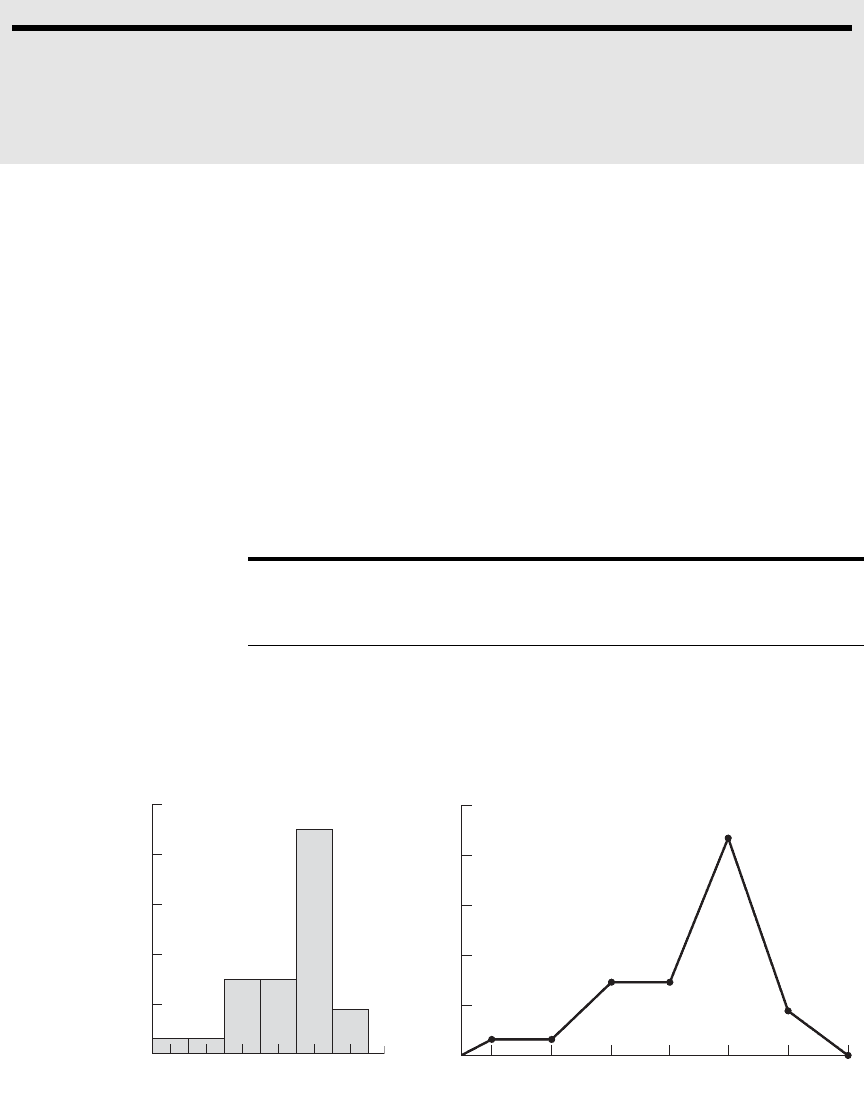
A-106
Chapter 1
Review Exercises
7. Situation A.
(a) 300 households (b) all households in the small southern town
(c) number of school-aged children present (d) all that reported one or
more children (e) nominal (categories: 0 children, 1 child, and so on)
Situation B.
(a) 250 patients (b) all patients admitted to the hospital during the past year
(c) distance patient lives from the hospital (d) 250 distances (e) ratio
Chapter 2
2.3.1. (a)
Cumulative
Class Cumulative Relative Relative
Interval Frequency Frequency Frequency Frequency
0–0.49 3 3 3.33 3.33
.5–0.99 3 6 3.33 6.67
1.0–1.49 15 21 16.67 23.33
ANSWERS TO
ODD-NUMBERED EXERCISES
(Continued)
Pindex
Histogram of pindex
0
10
20
30
40
50
Frequency
0.750.25 1.25 1.75 2.25 2.75
Pindex
Frequency polygon of pindex
0
10
20
30
40
50
Frequency
0.750.25 1.25 1.75 2.25 2.75 3.25
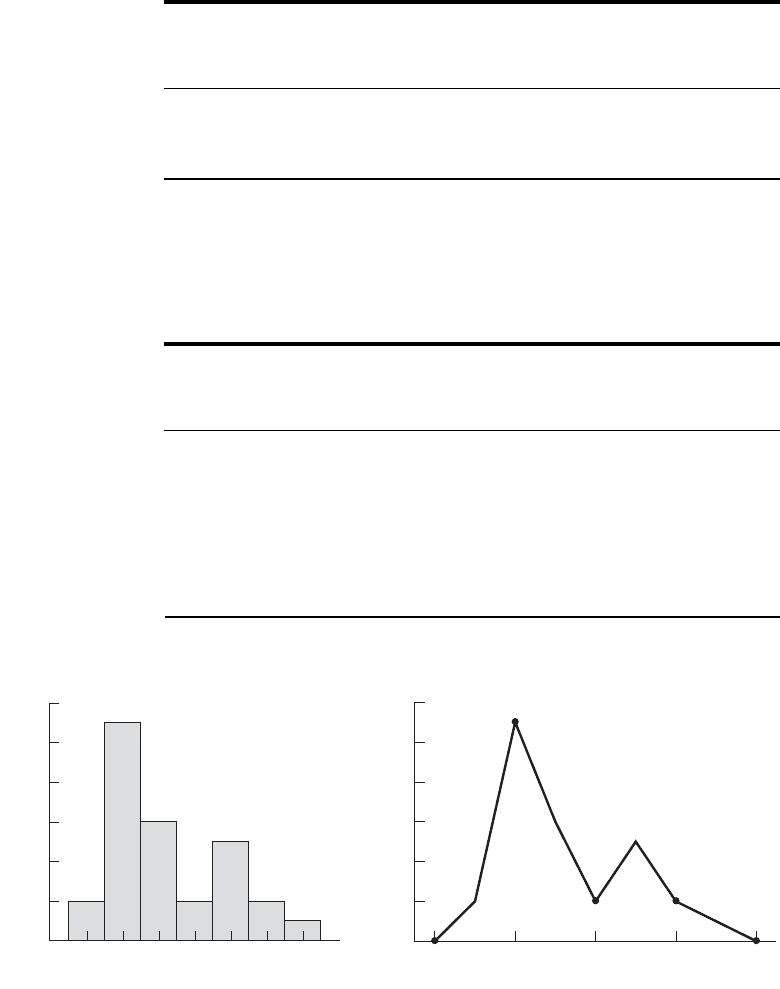
ANSWERS TO ODD-NUMBERED EXERCISES A-107
Cumulative
Class Cumulative Relative Relative
Interval Frequency Frequency Frequency Frequency
1.5–1.99 15 36 16.67 40.00
2.0–2.49 45 81 50.00 90.00
2.5–2.99 9 90 10.00 100.00
(b) 40.0% (c) .7667 (d) 16.67% (e) 9 (f) 16.67%
(g) 2.17, because it composes almost 25 percent of the data and is the most
frequently occurring value in the data set. (h) Skewed to the left.
2.3.3. (a)
Cumulative
Class Cumulative Relative Relative
Interval Frequency Frequency Frequency Frequency
20–24.99 2 2 0.069 6.90
25–29.99 11 13 0.3793 44.83
30–34.99 6 19 0.2069 65.52
35–39.99 2 21 0.069 72.41
40–44.99 5 26 0.1724 89.66
45–49.99 2 28 0.069 96.55
50–54.99 1 29 0.0345 100.00
BMI
Histogram of BMI
0
10
12
6
8
2
4
Frequency
22.5 27.5 32.5 37.5 42.5 47.5 52.5
BMI
Frequency polygon of BMI
0
10
12
6
8
2
4
Frequency
17.5 27.5 37.5 47.5 57.5
(b) 44.83% (c) 24.14% (d) 34.48% (e) The data are right
skewed (f) 21
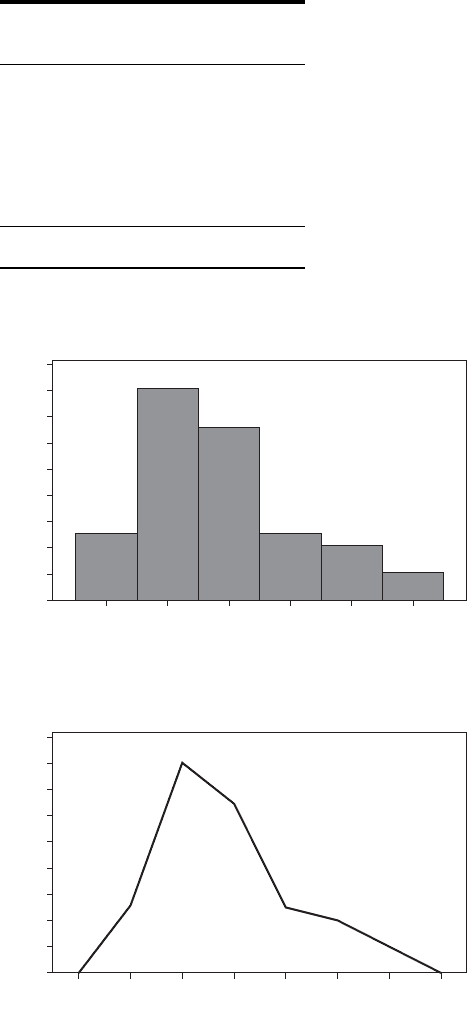
2.3.5. (a)
Class Relative
Interval Frequency Frequency
0–2 5 0.1111
3–5 16 0.3556
6–8 13 0.2889
9–11 5 0.1111
12–14 4 0.0889
15–17 2 0.0444
45 1.000
A-108
ANSWERS TO ODD-NUMBERED EXERCISES
18
16
14
12
10
8
6
4
2
0
Hours
Histogram of Hours
Frequency
147101316
–2
18
16
14
12
10
8
6
4
2
0
14710
Hours
Frequency Polygon of Hours
Frequency
13 16 19
(b) Skewed right
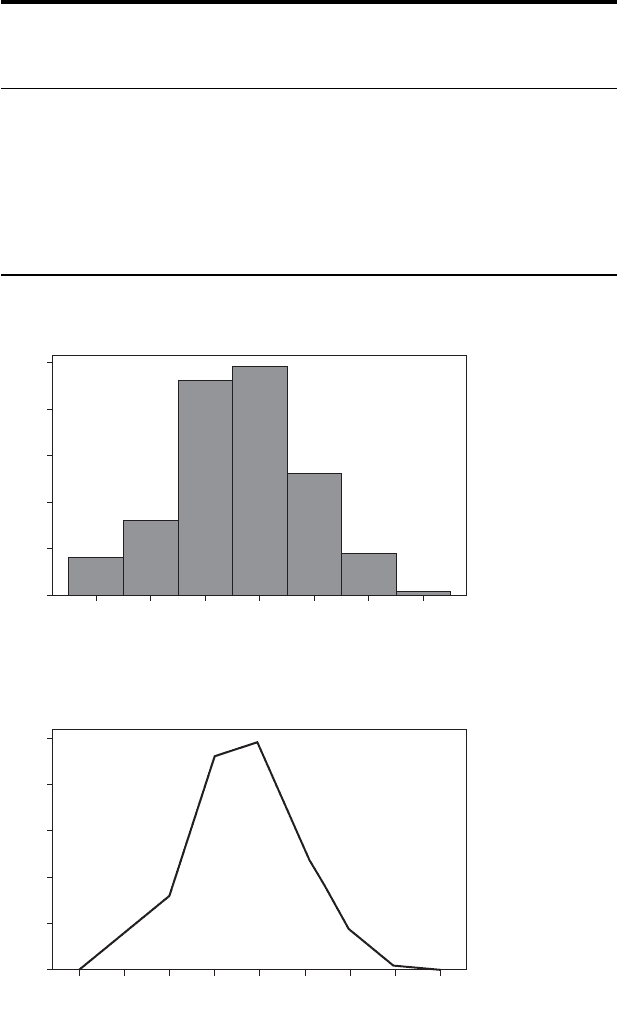
ANSWERS TO ODD-NUMBERED EXERCISES A-109
2.3.7. (a)
Cumulative
Class Cumulative Relative Relative
Interval Frequency Frequency Frequency Frequency
110–139 8 8 0.0516 0.0516
140–169 16 24 0.1032 0.1548
170–199 46 70 0.2968 0.4516
200–229 49 119 0.3161 0.7677
230–259 26 145 0.1677 0.9354
260–289 9 154 0.0581 0.9935
290–319 1 155 0.0065 1.0000
50
40
30
20
10
0
Histogram of Scores
Frequency
125 155 185 215
Scores
245 275 305
95
50
40
30
20
10
0
125 155 185 215
Scores
Frequency Polygon of Scores
Frequency
245 275 305 335
(b) Not greatly skewed
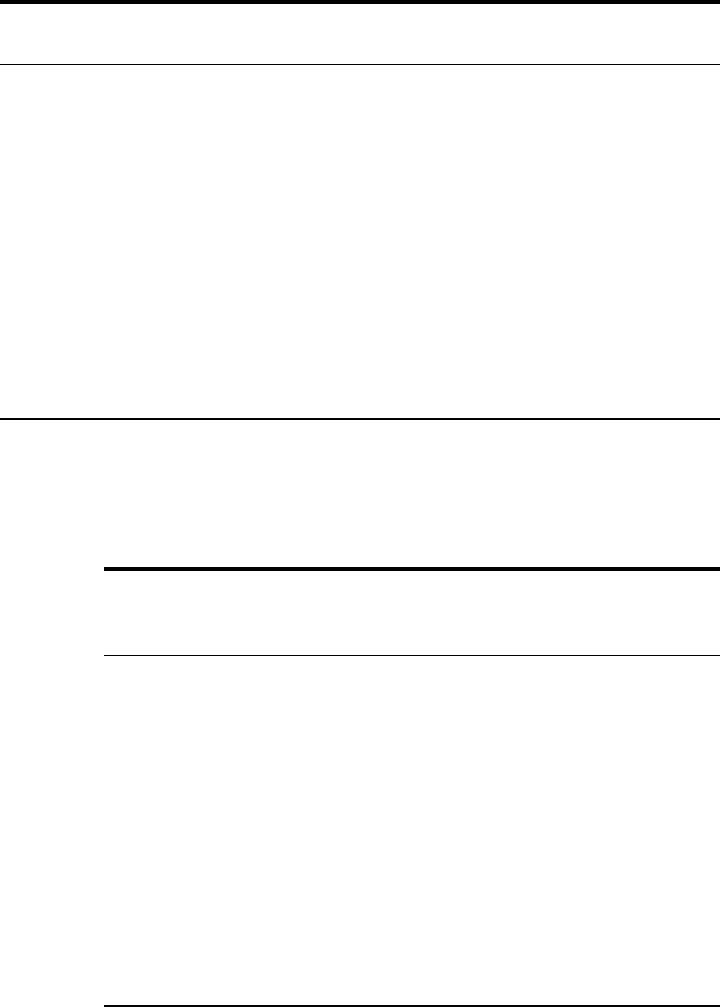
2.3.9. (a)
Stem-and-Leaf Display: Stem-and-Leaf Display:
Hospital A Hospital B
Stem-and-leaf of C1 N = 25 Stem-and-leaf of C2 N = 25
Leaf Unit = 1.0 Leaf Unit = 1.0
1 171 1 125
2 184 2 135
4 19 15 4 14 35
9 20 11259 9 15 02445
(6) 21 233447 (4) 16 5678
10 22 2259 12 17 38
6 23 389 10 18 466
3 24 589 7 19 0059
3203
22124
(b) Both asymmetric: A is skewed left, and B is skewed right.
2.3.11. (a)
Cumulative
Class Cumulative Relative Relative
Interval Frequency Frequency Frequency Frequency
.0–.0999 45 45 20.83 20.83
.1–.1999 50 95 23.15 43.98
.2–.2999 34 129 15.74 59.72
.3–.3999 21 150 9.72 69.44
.4–.4999 23 173 10.65 80.09
.5–.5999 12 185 5.56 85.65
.6–.6999 11 196 5.09 90.74
.7–.7999 6 202 2.78 93.52
.8–.8999 4 206 1.85 95.37
.9–.9999 5 211 2.31 97.69
1.0–1.0999 4 215 1.85 99.54
1.1–1.1999 1 216 0.46 100.00
A-110
ANSWERS TO ODD-NUMBERED EXERCISES
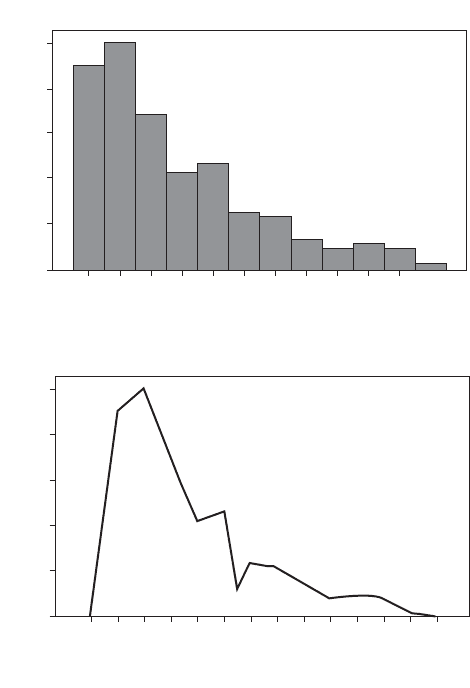
ANSWERS TO ODD-NUMBERED EXERCISES A-111
50
40
30
20
10
0
S/R Ratio
Frequency Polygon of S/R Ratio
Frequency
–0.05
0.05
0.15
0.25
0.35
0.45
0.55
0.65
0.75
0.85
0.95
1.05
1.15
1.25
Stem-and-leaf of C1 N = 216
Leaf Unit = 0.010
46 0 1245566777888899999999999999999999999999999999
96 1 00000000001122233334444555555666666677777778888999
(34) 2 0011111223444444445566666788889999
86 3 001111244445556668999
65 4 00001122223333444568899
42 5 002334444599
30 6 02236788999
19 7 012289
13 8 0237
9 9 05588
4 10 236
1116
0.05
50
40
30
20
10
0
0.15 0.25 0.35 0.45
S/R Ratio
Histogram of S/R Ratio
Frequency
0.55 0.65 0.75 0.85 0.95 1.05

(b) Skewed right (c) 10, 4.62% (d) 196, 90.74%; 67, 31.02%, 143, 19.91%
2.5.1. (a) 193.6 (b) 205.0 (c) no mode (d) 255 (e) 5568.09
(f) 74.62 (g) 38.53 (h) 100.5
2.5.3. (a) 47.42 (b) 46.35 (c) 54.0, 33.0 (d) 29.6 (e) 76.54
(f) 8.75 (g) 18.45 (h) 13.73
2.5.5. (a) 16.75 (b) 15 (c) 15 (d) 43 (e) 124.02
(f) 11.14 (g) 66.51 (h) 8.25
2.5.7. (a) 1.8172 (b) 2 (c) 2.17 (d) 2.83 (e) .3165
(f) .5625 (g) 30.96 (h) .6700
2.5.9. (a) 33.87 (b) 30.49 (c) none (d) 29.84 (e) 64.00
(f) 8.00 (g) 23.62 (h) 13.4
2.5.11. (a) 6.711 (b) 7.00 (c) 7.00 (d) 16 (e) 16.21
(f) 4.026 (g) 59.99 (h)
5.5
2.5.13. (a) 204.19 (b) 204 (c) 212, 198 (d) 196 (e) 1258.12
(f) 35.47 (g) 17.37 (h) 46
Review Exercises
13. (a) Leaf Unit = 1.0
2255
4267
7 2 999
10 3 001
17 3 2223333
(12) 3 444555555555
21 3 666666666666666666677
(b) skewed (c) surgery is performed before birth; birth is generally around
37 weeks (d)
15. (a)
(b) Stem-and-leaf of GFR N = 28
Leaf Unit = 1.0
118
6 2 11377
12 3 022267
(7) 4 1223388
9 5 158
6 6 02378
17
188
(c) See graph on following page (A-113)
(d) 67.9%, 96.55%, 100%
x
= 43.39, median = 42, s = 17.09, C.V. = 39.387, s
2
= 292.07
x = 33.680, median = 35.00, s = 3.210, s
2
= 10.304
A-112 ANSWERS TO ODD-NUMBERED EXERCISES
